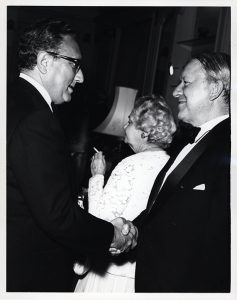Main Exhibit Page | The Vineyard Gazette | Scotty Writes His Memoirs | Credits and Exhibit Sources

Found in RS 26/20/120, Box 137, General Photographs, Undated.
A Man of the Center
Throughout his reign as the country’s preeminent journalist, Scotty was a man of the center: he supported liberal domestic reforms and the American government’s policy to contain communist expansion across the globe.[1] Although Scotty was skeptical of those in power, he remained close to these influential figures.[2] By 1969, when Scotty returned to Washington after his tenure as Executive Editor of the New York Times, the Vietnam War (1961-1975) was discrediting the liberal center of his era.[3] Initially, Scotty believed America’s involvement in Vietnam was justified on the premise that it would halt the advance of Communist North Vietnam into South Vietnam. As the war progressed, however, he frequently voiced doubts about the war[4], arguing that, in their efforts to defeat the North Vietnamese-supported guerrilla insurgency, the United States Army was destroying the South Vietnamese communities that they were supposed to be protecting.[5]

Found in RS 26/20/120, Box 40, Folder: Joseph Alsop, 1949, 1954, 1965.
Despite Scotty’s qualms about the war, his proteges, including David Halberstam, a Times war correspondent, criticized him for not publicly opposing the war. Although Halberstam appreciated Scotty’s courageous defense of his critical reporting of the war in the face of virulent war hawks, such as columnist Joseph Alsop, he believed Scotty’s proximity to power compromised his analysis and reputation.[6] Scotty’s budding relationship with Henry Kissinger, President Richard Nixon’s National Security Advisor, symbolized this troubling trend.
The Kissinger Seduction

Found in RS 26/20/120, Box 40, Folder: Joseph Alsop, 1949, 1954, 1965
The 1969 ascent of Richard M. Nixon to the Presidency of the United States jeopardized Scotty’s access to
power. Nixon was notoriously hostile to the press and forbade members of his staff from speaking to print media.[7] Henry Kissinger became one of the few administration officials willing to disregard Nixon’s directive and clandestinely leaked information to journalists. Kissinger assiduously cultivated these relationships, believing Nixon would retain him as National Security Advisor if he maintained his own popularity in the media.[8] Scotty reciprocated Kissinger’s attention, much to the consternation of his colleagues, who increasingly accused him of becoming Kissinger’s mouthpiece. Scotty’s critics cited his published response to the Christmas 1972 bombings of North Vietnam as the damning evidence.[9]
The controversy occurred on December 18, 1972, when Nixon ordered the bombing of North Vietnam in retaliation for stalled peace negotiations between the United States and North Vietnam in Paris, igniting fierce opposition by the public.[10] In a December 31, 1972 column, entitled “Nixon and Kissinger,” Scotty absolved
Kissinger of responsibility for the attack, claiming Kissinger opposed the bombing, forcing Nixon to cease the military strike on December 30, 1972, to prevent Kissinger from resigning.[11] In fact, Kissinger privately recommended the bombing and merely told Scotty the sanitized version of events to bolster his popularity.[12] Scotty’s defense of Kissinger damaged his credibility among his colleagues; it now seemed that Scotty was no longer one of them: a reporter.[13] Although Scotty continued to write his column, he began seeking solace from a potential increasing irrelevance, most notably in a small country newspaper, the Vineyard Gazette.
Continue to: The Vineyard Gazette
Footnotes
[1] John F. Stacks, Scotty: James B. Reston and the Rise and Fall of American Journalism (Boston: Little, Brown, 2003), 240, 250; J. Anthony Lucas, “Say it Ain’t So, Scotty,” MORE: A Journalism Review 2, (May 1973): 22.
[2] Ibid, 20.
[3] James T. Patterson, Grand Expectations: The United States, 1945-1974 (New York: Oxford University Press, 1996), 597-598, 600.
[4] Stacks, Scotty, 240-241; James Barrett Reston, “Why Vietnam? —Fiery Run, April-May 1989, James B. Reston Papers, 1935-1995; Record Series 26/20/120, Box 9, Folder: Why Vietnam? —Fiery Run, April-May, 1989, The University of Illinois Archives.
[5] James Reston, “Saigon: The Tragic Paradox of Vietnam,” New York Times, August 29, 1965, accessed June 19, 2016, ProQuest Historical Newspapers.
[6] Lukas, “Say it Ain’t So, Scotty,” 20, 22; Stacks, Scotty, 244-245; Joseph Alsop to James Reston, November 19, 1965, James B. Reston Papers, 26/20/120, Box 40, Folder: Joseph Alsop, 1949, 1954, 1965, The University of Illinois Archives; James Reston to Joseph Alsop, November 27, 1965, Box 40, Folder: Joseph Alsop, 1949, 1954, 1965.
[7] Stacks, Scotty, 300-301.
[8] Ibid, 314-316.
[9] Ibid, 319.
[10] Stanley Karnow, Vietnam: A History (New York: Viking, 1983), 652, 654.
[11] James Reston, “Nixon and Kissinger,” New York Times, December 30, 1972, accessed June 19, 2016, ProQuest Historical Databases.
[12] Stacks, Scotty, 323.
[13] Ibid, 327-329; “Tom Wicker Interview,” John F. Stacks Papers, 1914-2003; Record Series 26/20/157, Box 2, Folder: Notes from Tape Recorded Interviews, University of Illinois Archives; Stephen Chapman, “Reston on His Laurels,” The New Republic, April 19, 1980, accessed May 1, 2016, https://newrepublic.com/article/ 116786/Stephen-chapman-james-reston; Lukas, ‘Say it Ain’t So, Scotty,’ 20, 22.